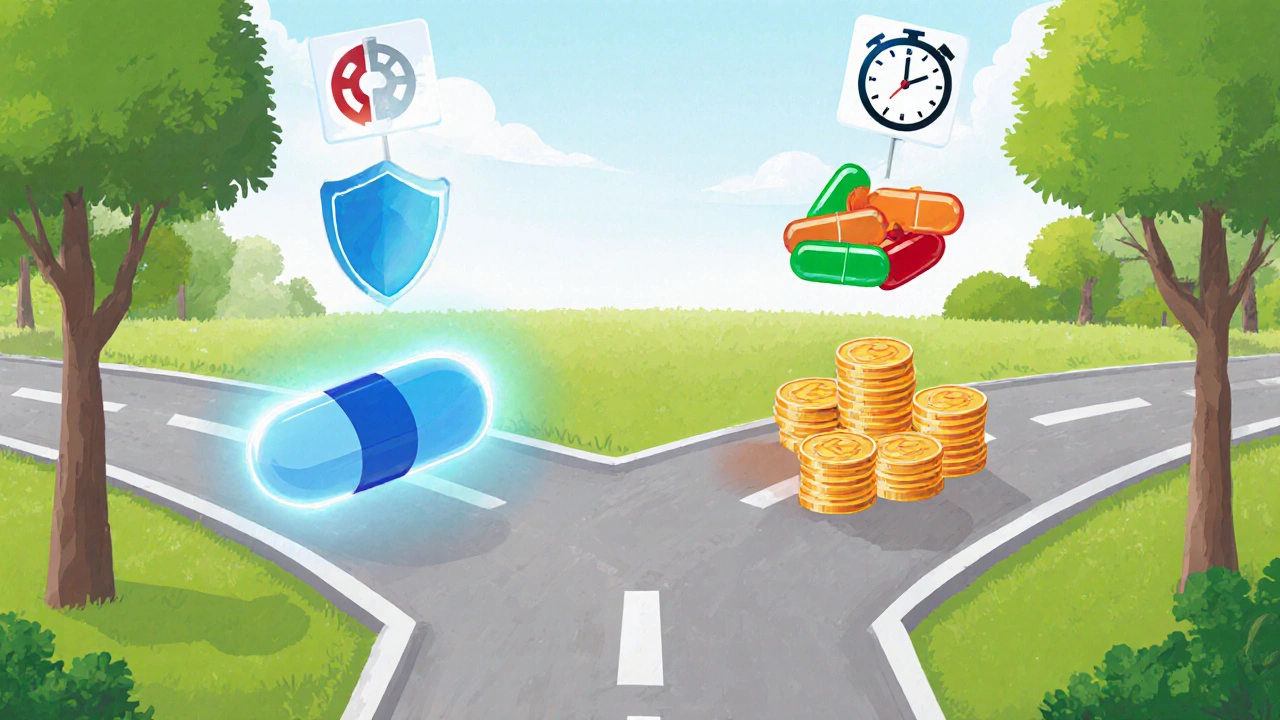28 Sep 2025
- 17 Comments
Anti-Nausea Medication Selector
Select Your Conditions and Preferences
Recommended Medication:
Feeling queasy can wreck a day, and choosing the right medicine isn’t always easy. Motilium (Domperidone) is a popular prescription drug that many turn to for relief, but there are several other options that might fit better depending on your health profile, cost concerns, or how quickly you need symptom control.
TL;DR - Quick Takeaways
- Motilium blocks dopamine receptors in the gut, easing nausea without strong central nervous system effects.
- Metoclopramide works faster but can cause fatigue and movement disorders.
- Ondansetron is the go‑to for chemotherapy‑induced nausea but is pricier.
- Erythromycin and Prochlorperazine are useful in specific cases, yet each carries its own side‑effect profile.
- Natural ginger offers a low‑risk OTC alternative, especially for mild symptoms.
What Is Motilium (Domperidone)?
Domperidone is a peripheral dopamine‑D2 receptor antagonist approved in many countries for nausea, vomiting, and gastric motility disorders. By blocking dopamine in the chemoreceptor trigger zone of the gut (but not in the brain), it helps food move faster through the stomach, reducing the feeling of fullness and the urge to vomit. Typical adult dosing ranges from 10mg to 20mg taken three to four times daily before meals.
How Does Motilium Differ From Other Anti‑Nausea Drugs?
Most anti‑nausea agents target either neurotransmitters in the brain (serotonin, dopamine) or the gut’s motility. Motilium’s peripheral action means it rarely causes drowsiness-a common complaint with drugs that cross the blood‑brain barrier. However, it can interact with certain heart medications and isn’t recommended for patients with prolonged QT intervals.
Key Decision Criteria When Comparing Anti‑Nausea Medications
- Efficacy: How well does the drug relieve nausea in clinical trials?
- Onset of Action: Minutes, hours, or days?
- Side‑Effect Profile: Sedation, extrapyramidal symptoms, cardiac risks?
- Pregnancy & Breast‑feeding Safety: Important for women of child‑bearing age.
- Prescription vs. OTC: Convenience and insurance coverage.
- Cost: Generic availability, insurance co‑pay, or out‑of‑pocket price.

Comparison Table of Common Alternatives
| Medication | Mechanism | Typical Dose | Onset | Common Side Effects | Pregnancy Safety | Prescription? | Avg. Monthly Cost (USD) |
|---|---|---|---|---|---|---|---|
| Domperidone (Motilium) | D2‑receptor antagonist (peripheral) | 10‑20mg 3‑4×/day | 30‑60min | Dry mouth, headache, QT prolongation (rare) | Category C; use only if benefits outweigh risks | Prescription | $15‑$30 |
| Metoclopramide | D2‑receptor antagonist (central & peripheral) | 10mg 3‑4×/day | 15‑30min | Drowsiness, fatigue, tardive dyskinesia (long‑term) | Category B; generally safe | Prescription | $10‑$20 |
| Ondansetron | 5‑HT3 receptor antagonist | 4‑8mg PO q8h | 5‑15min | Constipation, headache, QT prolongation | Category B; limited data | Prescription | $45‑$70 |
| Erythromycin | Macrolide antibiotic with pro‑kinetic effect | 250mg q6h | 60‑90min | GI upset, taste disturbance, liver enzyme elevation | Category B | Prescription (often OTC in low dose) | $12‑$25 |
| Prochlorperazine | Phenothiazine dopamine blocker | 5‑10mg PO q6‑8h | 30‑45min | Drowsiness, extrapyramidal symptoms | Category C; avoid in early pregnancy | Prescription | $8‑$15 |
| Ginger (Zingiber officinale) | Natural anti‑emetic; acts on GI tract and central pathways | 1‑2g powdered / day | 45‑60min | Heartburn, mild diarrhea | Category A; safe in pregnancy | OTC (supplement) | $5‑$10 |
Deep Dive Into Each Alternative
Metoclopramide is often the first‑line choice when rapid relief is needed, such as after surgery or for diabetic gastroparesis. Its central action can cause sedation, making it less attractive for people who need to stay alert. The risk of tardive dyskinesia rises after a month of continuous use, so short courses are recommended.
Ondansetron shines in chemotherapy‑induced nausea, postoperative nausea, and radiation therapy. Because it targets serotonin receptors, it bypasses dopamine‑related side effects, but the price tag can be steep without insurance coverage. Its QT‑prolonging potential is similar to Motilium, so doctors often run a baseline ECG for high‑risk patients.
Erythromycin is an old‑school option that doubles as an antibiotic. At low doses (250mg), it stimulates motilin receptors, speeding gastric emptying. However, its bitter taste and possible drug interactions (especially with statins) limit its popularity.
Prochlorperazine belongs to the phenothiazine family and is effective for severe nausea from migraines or vertigo. Its antipsychotic lineage means it can cause noticeable drowsiness and, in rare cases, movement disorders. It’s a solid backup when dopamine blockade is needed but Metoclopramide isn’t tolerated.
Ginger may sound like a kitchen spice, but multiple randomized trials have shown it reduces nausea from pregnancy, motion sickness, and chemotherapy at doses around 1g daily. It’s cheap, readily available, and safe for most, though high amounts might irritate the stomach.
Choosing the Right Option for You
Think of the decision as a short checklist:
- How quickly do you need relief? For minutes‑level urgency, consider Metoclopramide or Ondansetron.
- Are you pregnant or planning to become pregnant? Ginger and low‑dose Erythromycin are safest; Motilium and Prochlorperazine fall into Category C.
- Do you have heart issues or take other QT‑affecting drugs? Avoid both Motilium and Ondansetron unless doctor monitors ECG.
- Is cost a major factor? Generic Metoclopramide and Prochlorperazine are the cheapest prescription options; ginger is the cheapest overall.
- Do you need a prescription? If you prefer OTC, ginger or low‑dose Erythromycin (available in some regions) are your go‑to.
After you answer these, you’ll have a clearer picture of which medication aligns with your priorities.
Safety Tips & Common Interactions
- Never combine two dopamine antagonists (e.g., Motilium+Metoclopramide) without medical supervision.
- Check for CYP3A4 interactions: Motilium can raise levels of certain antifungals and some heart meds.
- For patients on cardiac drugs (e.g., amiodarone, sotalol), an ECG before starting Motilium or Ondansetron is advisable.
- Alcohol may increase dizziness when taking Prochlorperazine or Metoclopramide.
- Store all medications at room temperature, away from moisture; ginger capsules should be kept in a cool, dry place.
When to Seek Professional Help
If nausea persists longer than three days, is accompanied by severe abdominal pain, vomiting blood, or unexplained weight loss, see a clinician promptly. These signs may indicate an underlying condition that needs targeted treatment beyond anti‑emetics.

Frequently Asked Questions
Can I take Motilium and Metoclopramide together?
Usually no. Both block dopamine receptors and can amplify side effects like dizziness or cardiac rhythm changes. Always ask a doctor before stacking anti‑nausea drugs.
Is ginger as effective as prescription medication?
For mild to moderate nausea, especially in pregnancy or motion sickness, ginger performs comparably to low‑dose Metoclopramide in clinical studies. It won’t match the speed of Ondansetron for chemotherapy‑induced nausea.
What does ‘QT prolongation’ mean and why should I care?
QT prolongation is a lengthening of a specific interval on an ECG that can predispose you to a dangerous heart rhythm called torsades de pointes. Both Motilium and Ondansetron can cause this in susceptible people, so doctors may order a baseline ECG if you have heart disease or take other QT‑affecting drugs.
Is Motilium available over the counter?
In most countries, Domperidone requires a prescription because of its cardiac safety profile. Some regions allow low‑dose versions for short‑term use, but it’s best to check local regulations.
Can I use Motilium for acid reflux?
Domperidone can improve gastric emptying, which may reduce reflux episodes, but it’s not a first‑line treatment. Proton‑pump inhibitors or H2 blockers are usually recommended first.


Sally Murray
September 28, 2025When evaluating anti‑emetic options, pharmacokinetics play a pivotal role in aligning therapy with patient needs.
Domperidone’s peripheral D2 antagonism confers a lower propensity for central sedation compared to metoclopramide.
Nevertheless, clinicians must remain vigilant about its QT‑prolonging potential, especially in poly‑pharmacy contexts.
The drug’s onset of 30‑60 minutes situates it between ginger’s gradual effect and ondansetron’s rapid action.
Thus, it occupies a niche for moderate‑severity nausea where speed and safety must be balanced.
Bridgett Hart
September 28, 2025Motilium is overrated and probably a waste of money.
Sean Lee
September 29, 2025The therapeutic index of domperidone is contingent upon hepatic CYP3A4 metabolism, which can be competitively inhibited by macrolides, thereby amplifying plasma concentrations.
In contrast, metoclopramide undergoes conjugative pathways, yielding a distinct metabolite profile.
From a pharmacodynamic perspective, the peripheral D2 blockade furnishes prokinetic benefits without substantial blood–brain barrier penetration.
However, the QT-interval elongation risk mandates ECG surveillance in patients on concurrent antiarrhythmics.
Cost‑effectiveness analyses frequently place domperidone above ondansetron due to generic availability.
Clinicians should also consider the drug–drug interaction matrix, especially with antifungal azoles.
The latency to anti-emetic effect approximates 45 minutes, aligning with moderate urgency scenarios.
Ultimately, individual patient comorbidities dictate optimal agent selection.
Michael Christian
September 30, 2025I agree with the point about balancing speed and safety; honestly, for most everyday queasiness I just keep a ginger supplement on hand and reserve something like Motilium for when the nausea really hits hard.
It’s nice to have that middle ground option that isn’t as sedating as some of the other prescriptions.
Steven Elliott
September 30, 2025Oh sure, because we should all just suffer in silence instead of having a drug that actually works.
Lawrence D. Law
October 1, 2025It is incumbent upon the prescribing practitioner to conduct a comprehensive assessment of the patient’s cardiovascular profile prior to initiating therapy with domperidone; the drug’s propensity to elicit QT‑interval prolongation, albeit infrequent, cannot be dismissed outright.
Furthermore, a rigorous evaluation of concomitant medication regimens is warranted to preempt potential pharmacokinetic interactions, particularly those involving CYP3A4 substrates.
Adherence to these precautionary measures ensures the therapeutic benefits of the agent are realized without undue risk.
Mary K
October 1, 2025Spot on! I always double‑check the patient’s med list and make sure the heart’s good before I write a script – better safe than sorry, right?
And if there’s any doubt, I just chat with the cardiologist and we pick the safest route together.
Odin Zifer
October 2, 2025What they don’t tell you is that the push for domperidone prescriptions is tied to big pharma’s agenda to keep us dependent on pricey brand‑name drugs while they hide cheaper natural alternatives.
Marisa Leighton
October 3, 2025There’s definitely a lot of noise out there, but the truth is that each medication has its place.
When you need quick relief, a prescription like Motilium can be a lifesaver, yet for mild cases ginger or lifestyle tweaks often do the trick.
It’s empowering to have options and to choose what feels right for your body.
Just remember to consult a healthcare professional so you’re not walking into a trap.
Stay informed and you’ll navigate the system much better.
Brennan Keeler
October 3, 2025Domperidone’s cardiac liability profile, specifically its propensity to induce torsades de pointes, renders it a high‑risk agent in any regimen that includes other QT‑prolonging compounds.
Chelsea Hackbarth
October 4, 2025👍 Got it – will watch the ECG and avoid mixing meds that could spike the risk.
Adam Shooter
October 4, 2025The epistemic hierarchy governing anti‑emetic selection is often obfuscated by a layperson’s myopic focus on immediate symptom abatement, neglecting the nuanced interplay of receptor pharmacology and systemic tolerability.
While ondansetron dominates the oncologic domain due to its serotonergic antagonism, domperidone occupies a distinct niche predicated upon peripheral dopaminergic modulation.
One must therefore adjudicate based on pathophysiological context rather than superficial potency alone.
Shanmughasundhar Sengeni
October 5, 2025Honestly this whole comparison feels like a textbook page – just give us the quick take, we don’t need all the fancy tables.
ankush kumar
October 6, 2025I hear you, but the depth of information actually serves a purpose beyond mere aesthetics; most readers appreciate a comprehensive view that delineates not only efficacy but also the mechanistic underpinnings of each agent.
When you consider the pharmacodynamic landscape, domperidone’s peripheral D2 antagonism distinguishes it from metoclopramide, which exerts central effects and thereby introduces a different side‑effect spectrum.
This distinction becomes crucial for patients who cannot tolerate sedation or extrapyramidal symptoms.
Moreover, the cardiac safety profile is not a footnote – QT prolongation, although rare, can be catastrophic in susceptible individuals, and that risk is mitigated by appropriate ECG monitoring.
Cost considerations also merit attention; while generic domperidone is affordable, the cumulative expense of multiple prescriptions can become burdensome without insurance coverage.
In pregnancy, ginger emerges as a safe, over‑the‑counter alternative, yet its onset is slower, making it less suitable for acute vomiting episodes.
For chemotherapy‑induced nausea, ondansetron remains the gold standard owing to its rapid onset and targeted serotonin blockade.
Patients with gastroparesis may benefit from the pro‑kinetic properties of low‑dose erythromycin, albeit with caution regarding antibiotic resistance.
Each drug’s indication, side‑effect profile, and interaction potential must be weighed against the individual’s comorbidities and lifestyle preferences.
That is why decision trees and comparison tables, while seemingly excessive, empower clinicians and patients to make evidence‑based choices.
In practice, I often start with the least invasive option and reserve prescription‑only agents for refractory cases.
Ultimately, the goal is to alleviate distress without introducing new problems, and achieving that balance requires more than a cursory glance at a chart.
Therefore, the thoroughness of the article, despite its length, aligns with the complexity of clinical decision‑making.
Cameron White
October 7, 2025Sometimes the simplest approach works best – stay hydrated and try ginger tea.
Amélie Robillard
October 7, 2025Sure, because a cup of ginger tea will magically cure a severe bout of chemo‑induced nausea 😒.
Fae Wings
October 8, 2025Wow, that was a marathon of info! I feel both enlightened and exhausted – thanks for breaking it down so thoroughly.